Uganda is well known not only for being home to gorillas and the great Lake Victoria but for being a charming, romantic land where the Nile river springs from.
[rpi]My journey across Africa has almost come to an end. I had a great time discovering some of the biggest national parks in the world, where wild animals live freely in their natural habitat. Though on this journey I was also confronted with the dark side of the Black Continent: poverty, famine, deteriorated roads, disease, and even rebels rage in some countries of the region. The places I passed through provided me with lasting memories. Peaceful Tanzania with the transcendent island Zanzibar – a beautiful harmony of man and nature – and Kenya, home to many exotic animals. I cannot believe how lucky I have been to witness the diversity and abundance of species that I had previously only seen on animal documentaries. These animals hunt, run, mate, and breed amidst the environmental problems that the continent is currently facing. The journey finally brought me to Uganda, famous not only for being home to gorillas and the great Lake Victoria but for being a charming, romantic land where the Nile river springs from.
Finding love in Murchison Park, Uganda
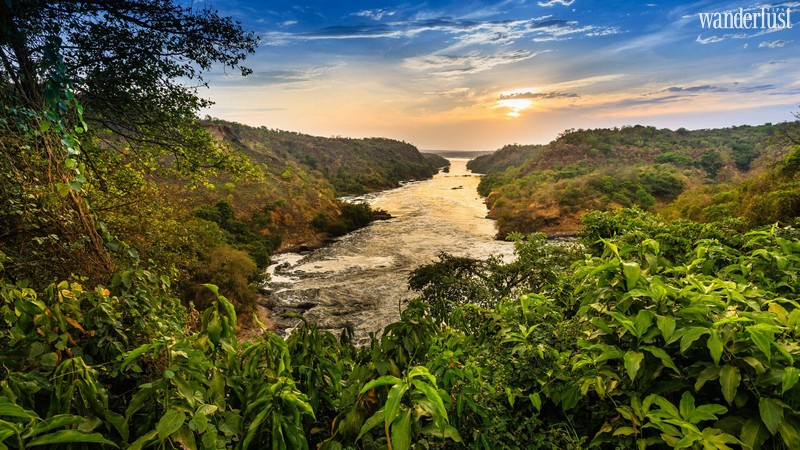
From Kampala, the capital city of Uganda, I hopped on a bus to travel up north to visit the famous Murchison National Park, where the Murchison waterfall plummets into the great Nile river of Africa. I covered over 300 kilometers. I left behind the cities and their modern buildings to be greeted by grassland and ancient flax trees, which only grow here. The roads in Uganda are smaller than those in its neighboring East African countries but are smooth enough to drive at high speeds. Occasionally, the driver stopped along the road for me to capture beautiful landscapes, dirt houses, or wild animals gnawing on dry grass on the red-brown hills. Located on the equator, Uganda is warmer than its neighboring countries, thanks to the high winds coming from the ocean. However, in the region of Lake Victoria in the country’s south, the weather is cooler and especially pleasant towards the end of the year.
After more than five hours on the bus, I finally reached the Nile, the longest river in the world, which runs through ten African countries. I didn’t choose to stay in luxury hotels or fully equipped bungalows, but rented a camping spot and pitched my tent provided by the bus at a rental price of only US$7. The bus driver advised me to lock the tent carefully, and not to leave food inside, or wild monkeys or hogs might pay me a visit at nighttime. The open camp space is located at the center of Murchinson National Park. There is no fence, so visitors get to live among the animals. That afternoon, we rushed to the river to catch the last boat trip down the Nile river to Murchinson falls.
Our experienced guide told us many stories about the animal species living along the Nile. Herds of hippos made up of a few hundred individuals bathing in the water made me feel as if I was part of a documentary on the Discovery Channel. Giant elephants and herds of African buffalos sunbath along the river, and colorful birds nest on the cliffside. Combined they create a peaceful and tranquil natural environment. Once, our guide motioned for us to stay silent and watch the riverside, and I was astonished to see giant Nile crocodiles with their mouths open, waiting for prey. Detecting the motion and noise of the boat approaching them, some dove down to the water, hoping for a juicy meal. The animals here live together peacefully without any threats. After 45 minutes, our boat finally approached the Murchison fall, its water roaring and plunging down into the river. The large body of water poured down from above, flowing through vertical cliffs, ancient forests, and the surrounding mountains to merge with the Nile. If the river was peaceful enough for herds of hippos to bathe downstream, this part of the river seemed angry thanks to the giant waves caused by the water hitting giant rocks in the river. The boat docked on a large rock so its passengers could enjoy the view of the waterfall from a distance
We returned to the Red Chilli campsite at dusk, the last sunlight of the day dyeing Murchison’s forest red. The campsite was busy preparing for dinner. Some Western travelers chose to face the Nile while enjoying a glass of white wine next to their barbeque. The bus driver and I struggled to kindle some coal fire to quickly cook some beef ramen, a Vietnamese specialty I brought from home, and then danced to the melodious tunes emanating from the bar area, located at the center of the campsite.
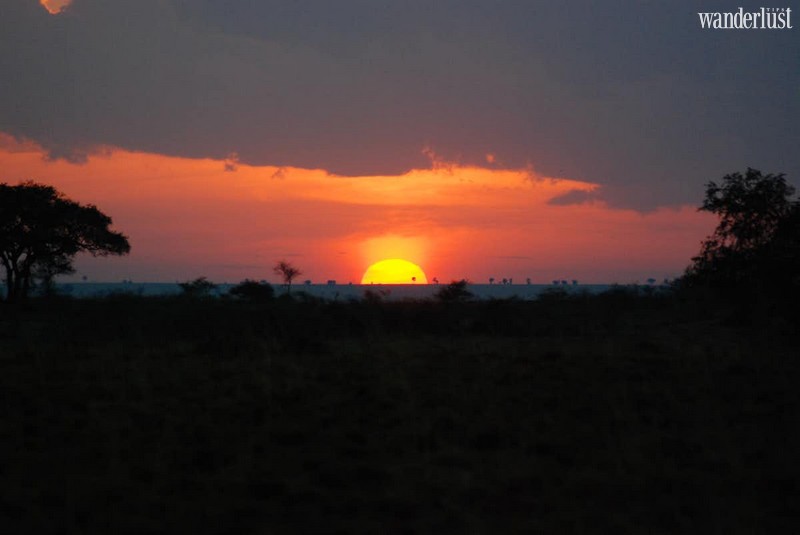
Darkness settled quickly, and the temperature dropped, bringing with it a cool night air. The golden moon was right above us, seemingly close enough to touch if I reached my hands out far enough. I stopped dead when suddenly I heard some rustle in the bushes, sounding like a wild animal hiding. Moments later, people across the campsite had their flashlights out, ready to find out what was hiding in the darkness. It turned out that a herd of wild boars was looking for food. It was quite a scare, but also an interesting experience of living in the wild.
The next morning, we departed the campsite quite early to witness some predators hunting in the wild. Soon after passing the Nile on a ferry, a sparse forest with tall trees and grasslands appeared. The roof of our car opened to welcome cool winds, and I took the opportunity to take some photos. The car passed through grass hills filled with deer and stags, fondly playing together by the trees. Upon the hills, I could see many other species such as warthogs, giraffes, ostriches, and pheasants all living together peacefully. I felt at one with nature. When I held up my camera and whistled at the deer, they looked at me curiously, as if they wanted to follow me home. Herds of buffalo made up of a few hundred animals grazed on the grasslands, white storks riding on their backs, waving their ears as if to welcome visitors. Unfortunately, I did not have the opportunity to see leopards hunting on the trees in Murchison. However, what I did witness was enough to paint a wild picture rarely seen anywhere else.
Jinja, upstream the Nile river, Uganda
The next day, I decided to travel South to visit Lake Victoria, one of the seven wonders of Africa, and travel upstream along the Nile river. Located 80 kilometers from the capital city of Kampala, the town of Jinja is filled with tourists from all over the world, who are here to experience adventure sports on the Nile river. My driver took me to a local travel agency to start my journey along the longest river on earth. Jinja is a small tourist town in Uganda, located on the riverside. South of the river is Lake Victoria, and up North is where the river merges into the great Nile. In this particular region, the river has a lot of rapids and is a few hundred meters wide, which makes the waves greater and more challenging.
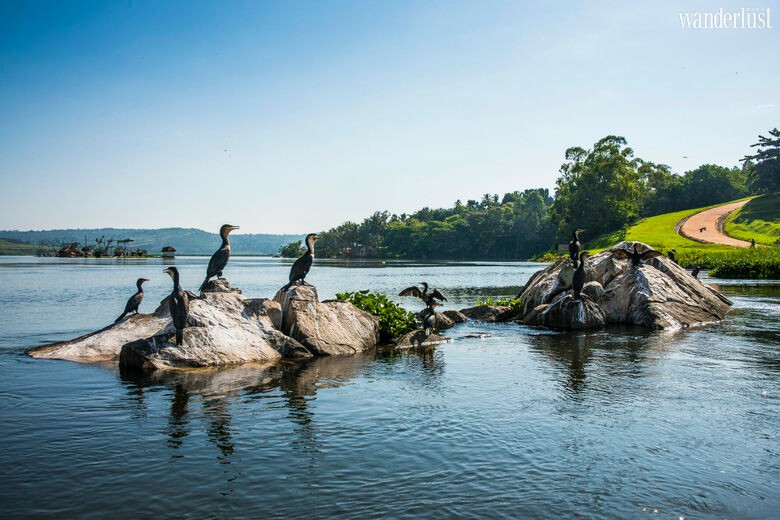
Thanks to this, there are many adventure sports on offer. If you want to try navigating the rapids, there is a crew there to support, guide, and even capture some once-in-a-lifetime photos for you. When I asked my South African guide about the difficulties of the sports he answered: “We have different options for different people. If you are adventurous and healthy, we can guide you through big rapids with steep slopes, which can really surprise and challenge you.” The surprise, my driver explained to me, turned out to be that the boat could flip so these thrill-seekers would fall into the strong waves. I chose to kayak along the river to feel the peaceful atmosphere of people and nature on the calm side of the Nile.
Today, some Ugandans also make their living from the Nile. In this region, men fish, farm, or work as tour guides, while women take care of children, do housework, and produce handicraft products to sell to tourists in Jinja. My guide shared that even though life was still tough here, hardly anyone hunted wild animals. They understood that wildlife had brought them their livelihoods, bringing an increasing number of tourists here.
The region is home to many unusual species of birds including white eagles. They stand lonely on tall trees on the small islands in the river, waiting for their prey. Other species, like robins and bluebirds, travel in flocks and make nests together in the rocks. Black and white kingfishers stretching out their wings and diving down quickly when they spot prey fascinated me. I spent three hours floating along the Nile river to absorb the peaceful harmony between nature and human life. This place seems like the birthplace of great things.
Tombs of the Kasubi kings in Kasubi, Uganda
The tombs of the Kasubi kings are a threatened heritage located about 5 kilometers from the capital city of Kampala, atop Kasubi Hill. I spent an afternoon here to learn about the feudal history of Uganda. These tombs and the palace are the epitomes of ancient African architecture. They are all made of reeds, spears, and wild animal products.
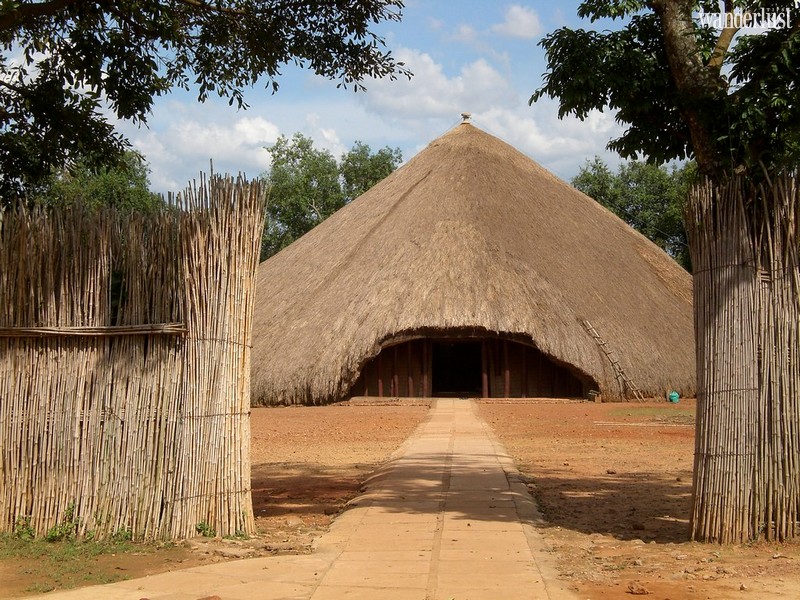
The ticket agent guided me around the heritage area including royal tombs and the burial place of four Buganda kings (formerly Kabaka): Muteesa I (1835-1884), Mwanga II (1867-1903), Daudi Chwa II (1896-1939), and Sir Edward Muteesa II (1924-1969). She led me into a complex of traditional buildings, displaying artifacts used for worship in ancient tribal ceremonies. According to the guide, the tombs were first built on the site of the Mutesa I royal cemetery in 1882. According to Bagandan tradition, after a king passes, his jaw is removed and placed in a separate royal temple, as it is believed that the jaw carries the soul. However, when Kabaka Mutesa I passed away, he was buried in his palace along with his jaw. His son Mwanga II wanted to follow the footsteps of his father and when he died on the Seychelles Islands, his body was brought back to his home country and buried next to his father. Mwanga II also had a son, Daudi Chwa II, who died in 1939. He too was respectably buried at this tomb. Daudi Chwa’s son, Edward Mutesa, took his place at a time of turbulence. He became the first president of Uganda. After a lifetime of achievements, he passed away in London. His body was buried alongside his father’s and ancestors’.
The guide led me further inside to visit the tombs. Makeshift houses are interspersed with brick houses, which serve as the homes of the kings’ descendants and concubines. These royal descendants of the feudal regime are still supported by the Ugandan government, receiving food, medicine, and education. Their lives are frugal. Women who were once concubines and the descendants of the kings come here to take care of their ancestor’s graves. They live inside the tombs as if it was a forbidden city. Unfortunately, on March 16, 2010, a mysterious fire completely destroyed the main area.
Tips
Travelling in Uganda
– Visa: For the Vietnamese, the government of Uganda accepts e-visa. You can apply online at the website: https://visas.immigration.go.ug/ to receive an electronic visa through email.
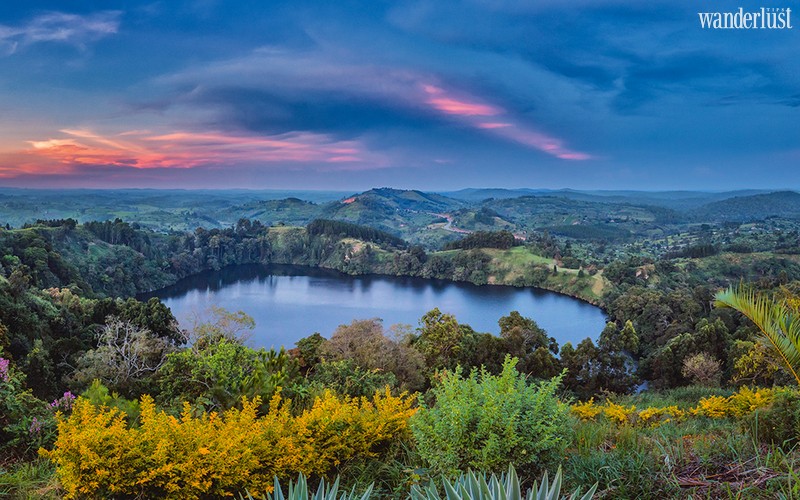
– Accommodation: Like its neighboring countries, safari tourism is highly developed in Uganda. You can book accommodation directly on booking.com or agoda.com to stay at expensive and modern resorts, with beautiful views of wildlife habitats. The Jacana Safari Lodge, located on Lake Nyamusingire (the largest volcanic lake in Uganda) is a great choice. For the romantics, a stay at the Mihingo Hotel to enjoy a beautiful view of the lake in Mburo National Park is recommended. Alternatively, you can stay at campsites with bungalows or tents available for rent at a lower cost.
– Transportation: You can use public transport when in Uganda, from local buses to high-end buses. In the capital city of Kampala, you can catch international buses to visit big cities in neighboring countries. There are bus routes directly from Kampala to Nairobi, Kigali, Bujumbura, Goma, Juba, or Dar es Salaam. You can also be dropped off in other cities along the routes. A typical journey from Kampala to Nairobi is about 12 hours, including time for customs procedures at the border of Gaza.
– What to eat: The traditional luwombo is a combination of meat, vegetables, and occasionally peanut butter, steamed in banana leaves. You can easily find this specialty in restaurants across Uganda.
– Shopping: You can buy local handicrafts as souvenirs such as carpets and hand-woven baskets made of Napier grass and palm leaves. These are sold along the street as well as at craft markets.
– What to see before you visit: You should see the film “The Last King of Scotland,” released in 2006. The story chronicles the rise and fall of the Idi Amin dictatorship. This was the first international film shot entirely in Uganda, with beautiful sequences capturing the wildlife and people here. For his role as Idi Amin in the film, American actor Forest Whitaker won a Golden Globe and an Oscar for best actor in 2007.
Must-sees in Uganda
– Ajai Game Reserve in Northern Uganda is located on the east bank of the Albert Nile.
– Bwindi Impenetrable National Park is where you can visit the great gorillas, rare Colobus monkeys, chimpanzees, and many species of birds.
– Mgahinga Gorilla National Park is located at the confluence of Rwanda and the Democratic Republic of the Congo. This is also the place to visit gorillas and many wildlife species of Africa.
– Kidepo Valley National Park is located in the Northeast of Uganda on the border with South Sudan. You can relax inside Apoka Lodge resort among wild animals including elephants, zebras, buffalos, and deer.
– Murchison Falls National Park is the place to visit primates, wild animals, and birds.
– Visit Queen Elizabeth National Park to see native plants, antelopes, and hippos.
– Kibale National Forest near Fort Portal is where you can visit chimpanzees and go bird watching.
– Rwenzori National Park is a mountain range in Western Uganda bordering the Democratic Republic of Congo and is home to the 5,109-metre tall Stanley peak.
– Ssese Island in Lake Victoria is home to many rare plant species.
– Lake Bunyonyi is the deepest lake in Africa.
Wanderlust Tips

